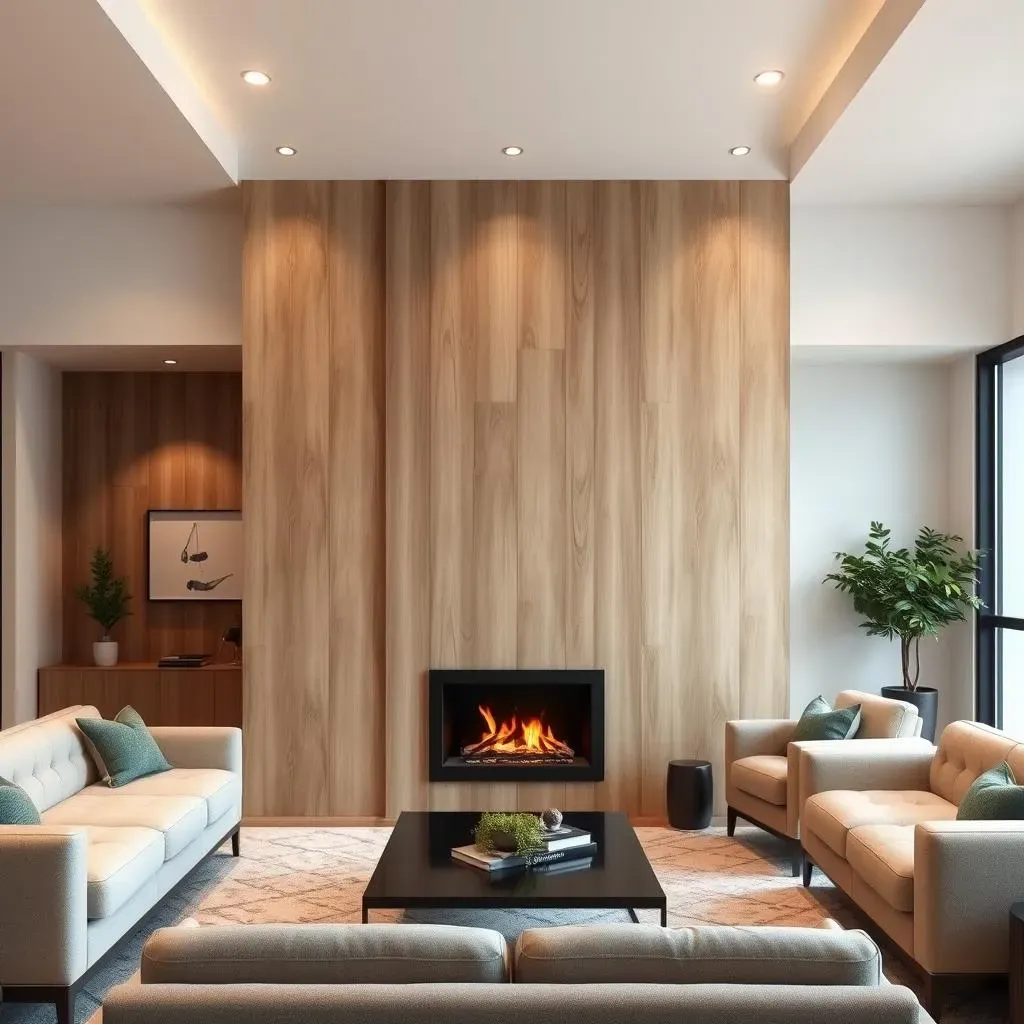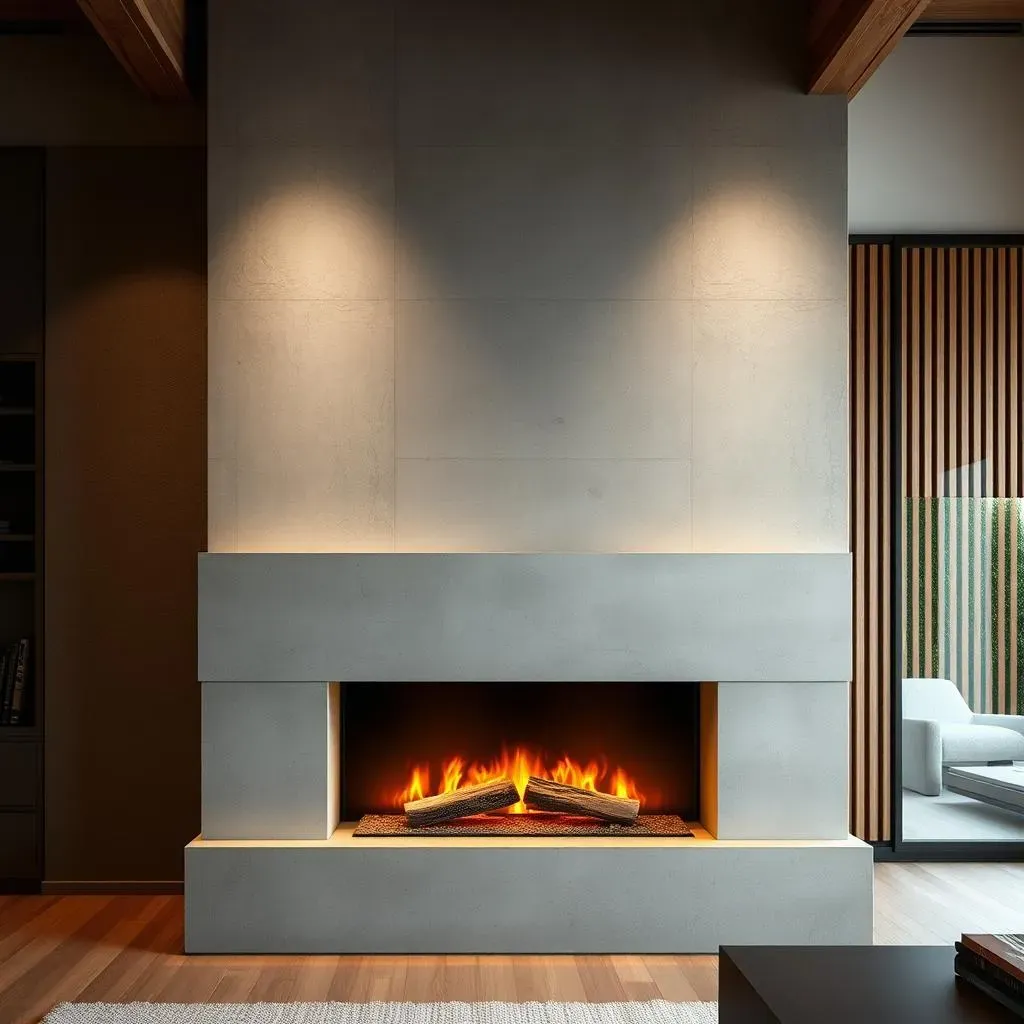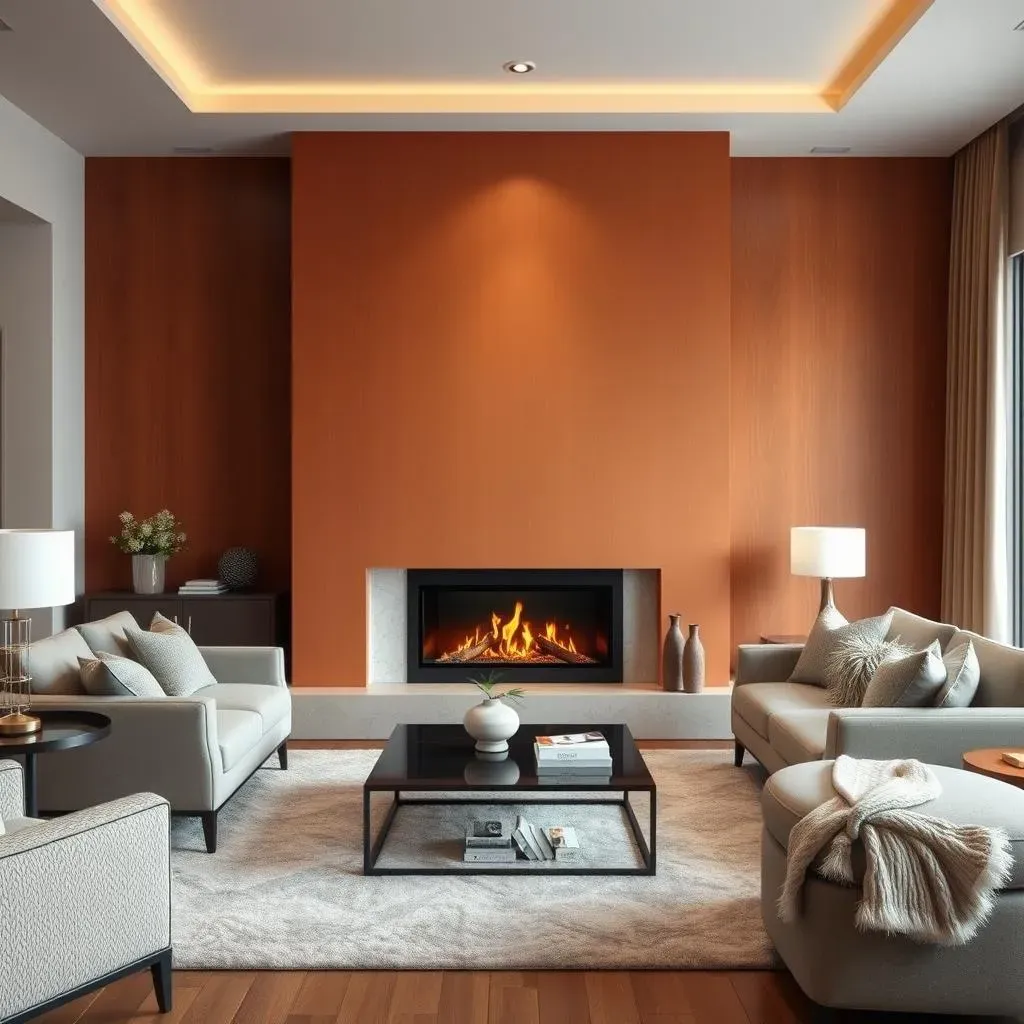Table of Contents
Ever felt like your fireplace is just... there? It’s time to change that! We're not talking about just another brick wall; we're diving headfirst into the world of "accent wall fireplace ideas" that can turn your living room from drab to fab. Think of your fireplace as a blank canvas, just waiting for a splash of personality. Whether you're aiming for a cozy, rustic vibe or a sleek, modern look, the right accent wall can make all the difference. In this article, I'll guide you through why an accent wall is the perfect partner for your fireplace, and explore some seriously cool material options. We’ll also chat about colors, decor, and even whether you should grab a hammer yourself or call in the pros. So, get ready to fire up your imagination and transform your fireplace into a show-stopping centerpiece.
Why Choose a Fireplace Accent Wall?

Why Choose a Fireplace Accent Wall?
The Focal Point Factor
Let's be real, a fireplace is already a natural magnet in a room. It's where our eyes drift, especially when it’s cold outside. But, sometimes, it just sits there like a forgotten toy. That's where an accent wall comes in – it's like giving your fireplace a spotlight. It instantly elevates the area from 'just a fireplace' to a 'wow, look at that fireplace!' It’s not just about aesthetics though, it is about creating a dynamic and engaging space.
Think about it: a plain wall just fades into the background, but a well-designed accent wall draws attention and sets the tone for the entire room. It's the difference between a stage and a corner. Do you want your fireplace to be noticed or just exist?
Adding Depth and Dimension
A fireplace accent wall isn't just about grabbing attention; it's also about adding some much-needed depth. A flat wall can make a room feel, well, flat. But by adding texture, color, or pattern through an accent wall, you're creating visual interest. It's like adding layers to a cake, or adding a new level to a video game. The room suddenly feels more complete and dimensional.
For instance, imagine a fireplace with a shiplap accent wall behind it. The lines of the shiplap add a sense of movement, and the shadows play off the texture. That's dimension in action! It can make a small room feel larger and a large room feel cozier, all thanks to the right accent.
Benefit | Description |
|---|---|
Focal Point | Draws attention to the fireplace, making it the star of the room |
Depth and Dimension | Adds visual interest and prevents the room from feeling flat |
Personal Style | Allows you to express your unique taste and personality |
Expressing Your Personal Style
Finally, and perhaps most importantly, an accent wall is your chance to let your personality shine. It's your canvas to express your unique style. Whether you're into bold colors, natural stone, or geometric patterns, your accent wall can reflect it all. It's about making your space truly yours. It's not about following trends; it's about creating a space that makes you happy.
If you are a person who loves a more organic look, a wood accent wall would be a good option, or a stone wall. If you're drawn to more sleek and modern designs, maybe a concrete or tile accent wall would be more suitable. There are no rules, just your preferences.
Creative Accent Wall Fireplace Material Ideas

Creative Accent Wall Fireplace Material Ideas
Timeless Texture: Stone and Brick
Okay, let's talk materials, the real meat of any good accent wall. When you think about a fireplace, stone and brick are probably the first things that pop into your head, and for good reason. They're classics that just work. A stone accent wall adds this raw, natural vibe, like you've brought a piece of the outdoors inside. Imagine a rugged, stacked stone wall behind your fireplace – it's cozy, it's durable, and it's got that timeless appeal. Plus, there are so many different types of stone to pick from, from smooth river rock to rough-hewn slate, so you can really dial in your desired aesthetic. Brick, on the other hand, gives a more industrial, urban feel. Think exposed brick in a loft apartment – it's got character, it's got history, and it's effortlessly cool. You can go for a classic red brick or try something different like painted or whitewashed brick for a lighter look.
I've seen some really neat fireplace designs that use a mix of stone and brick. Like a stone hearth with a brick accent wall above it. It's a great way to get the best of both worlds, creating a visually interesting and textured space. But remember, these materials can be a bit on the heavier side, so you might need to consider professional installation if you're not a DIY pro.
Modern Marvels: Wood, Tile, and Concrete
Now, if you're looking for something a bit more modern, let’s talk wood, tile, and concrete. Wood is surprisingly versatile; it can go from rustic to contemporary just by changing the finish and plank style. Think of a sleek, dark wood slat wall behind your fireplace – it's warm, inviting, and adds a touch of sophistication. Or, if you are feeling a bit more adventurous, try a geometric wood pattern for a statement piece. Tile is another fantastic option, and the choices are endless. From glossy subway tiles for a clean look to intricate Moroccan tiles for a touch of global flair, tile can really elevate your fireplace area. You can even play with different shapes and sizes to create a unique pattern. And let's not forget about concrete. Yes, concrete! It’s not just for sidewalks anymore. A concrete accent wall brings an industrial chic vibe that's both raw and refined. It's minimalist, it's durable, and it's definitely a conversation starter. You can leave it with a raw finish or polish it up for a sleeker look.
I've seen some really clever designs using these materials. Like a fireplace with a polished concrete surround and a wood slat wall behind it, or a fireplace with a colorful patterned tile surround and a simple painted wall. It's all about mixing and matching to create a look that's uniquely yours. But remember, each material comes with its own set of installation challenges, so plan accordingly.
Material | Style | Pros | Cons |
|---|---|---|---|
Stone | Rustic, Natural | Durable, Timeless | Heavy, Can be expensive |
Brick | Industrial, Urban | Character, Durable | Can feel heavy, Needs sealing |
Wood | Versatile, Warm | Inviting, Customizable | Can be damaged by heat, Needs maintenance |
Tile | Modern, Varied | Easy to clean, Lots of designs | Grout can get dirty, Installation can be tricky |
Concrete | Industrial, Chic | Minimalist, Durable | Can feel cold, Needs sealing |
Styling Your Fireplace Accent Wall: Colors & Decor

Styling Your Fireplace Accent Wall: Colors & Decor
Choosing the Right Colors
Alright, let's get to the fun part – color! The colors you choose for your fireplace accent wall can dramatically change the mood of your room. Think of it like picking an outfit; you want it to match the occasion and reflect your style. If you’re aiming for a cozy and warm feel, earthy tones like deep browns, warm grays, or even a muted terracotta can create that inviting atmosphere. These colors work wonders with natural materials like wood and stone, enhancing their inherent warmth. On the other hand, if you're going for a modern and sleek look, consider cooler tones like charcoal gray, navy blue, or even a crisp white. These colors can create a sophisticated and minimalist feel, especially when paired with materials like concrete or tile. Don't be afraid to go bold with a pop of color, either! A vibrant accent wall can be a real statement piece, but make sure it complements the rest of your decor.
Adding Personality with Decor
Now, let's talk about decor. It's not just about the wall itself; it's also about what you put on it. The right decor can really bring your fireplace accent wall to life. Think about adding a beautiful piece of artwork above your fireplace – it could be a painting, a sculpture, or even a cool mirror. Mirrors are great for bouncing light around the room and making the space feel bigger. Shelves are another fantastic option; you can use them to display your favorite books, plants, or decorative objects. And don't forget about lighting! A strategically placed wall sconce or a string of fairy lights can highlight the texture of your accent wall and create a warm and inviting glow. The key is to choose decor that reflects your personality and complements the overall style of your room. It should feel like an extension of you, not just a random collection of things.
Color Palette | Mood | Best Paired With |
|---|---|---|
Earthy Tones (Browns, Grays, Terracotta) | Cozy, Warm, Inviting | Wood, Stone |
Cool Tones (Charcoal, Navy, White) | Modern, Sleek, Sophisticated | Concrete, Tile |
Bold Colors (Vibrant Hues) | Statement, Unique, Energetic | Neutral Decor |
Balancing Act: Function and Style
Remember that your fireplace accent wall isn't just about looking pretty; it should also be functional. If you have a TV above your fireplace, consider how your accent wall will work with it. You might want to choose a color that doesn't clash with the screen, or add some built-in shelves to hide the cables. If you love to read by the fire, make sure you have good lighting. And if you have kids or pets, you might want to choose materials that are easy to clean. The best accent walls are those that are both beautiful and practical. It's about finding that perfect balance between form and function. So, think about how you actually use your space and how your accent wall can enhance that experience, not just look good in photos.
DIY vs. Professional Accent Wall Fireplace Installation

DIY vs. Professional Accent Wall Fireplace Installation
The DIY Route: Tools, Skills, and Time
So, you've got the vision for your dream fireplace accent wall, and now you're wondering if you should tackle it yourself. The DIY route can be super rewarding, but let's be real – it's not for everyone. Before you grab that hammer, you need to assess your skills. Are you comfortable with basic construction tasks like measuring, cutting, and installing? Do you have the necessary tools, like a level, a saw, and a drill? And perhaps most importantly, do you have the time? A DIY project can quickly turn into a never-ending saga if you're not prepared to commit. You might also run into unexpected issues, like uneven walls or tricky angles, that can throw a wrench in your plans. But, if you're up for the challenge, there's nothing quite like the satisfaction of building something with your own two hands. Just make sure you do your research, plan carefully, and be honest with yourself about your abilities.
I've seen some seriously impressive DIY fireplace accent walls, but I've also seen some that... well, let's just say they didn't quite turn out as planned. It's all about knowing your limits and not being afraid to ask for help when you need it. There are tons of online resources and tutorials that can guide you through the process, but nothing beats having some hands-on experience. So, if you're a DIY newbie, maybe start with a smaller project before tackling a full-blown accent wall.
Calling in the Pros: Expertise and Peace of Mind
Okay, maybe the thought of wielding a saw makes you break out in a cold sweat. That's totally fine! That's when professional installation comes in. Hiring a contractor might be the best option for you. Sure, it's going to cost more than a DIY project, but you're paying for expertise, efficiency, and peace of mind. A professional installer has the tools, the skills, and the experience to handle any challenges that might arise. They can also ensure that your accent wall is installed correctly and safely, which is especially important if you're dealing with heavy materials like stone or brick. Plus, they can often complete the project in a fraction of the time it would take a DIYer, and they will make sure that everything is up to code, so no surprises later. It's like having a personal chef versus cooking for yourself; both get the job done, but one is definitely easier and less stressful.
I always say that paying for a good contractor is an investment in your home. They can bring your vision to life with precision and care, ensuring that your accent wall not only looks great but also lasts for years to come. If you have a complex design or you're working with expensive materials, it's often better to leave it to the pros. There's nothing worse than spending a ton of money on materials, only to mess up the installation. So, if you value your time, your sanity, and the quality of the finished product, don't hesitate to call in the experts.
Factor | DIY | Professional Installation |
|---|---|---|
Cost | Lower | Higher |
Time | Longer | Shorter |
Skill Level | Requires some construction skills | Requires no skills |
Tools | Requires own tools | Tools included |
Stress | Can be stressful | Less stressful |
Quality | Depends on your skill | High quality guaranteed |
Making the Right Choice for You
Ultimately, the decision to DIY or hire a professional depends on your individual circumstances. If you're a confident DIYer with the skills, tools, and time, then go for it! You can save some money and enjoy the satisfaction of creating something yourself. But if you're not comfortable with construction tasks, or if you want to ensure a high-quality, hassle-free installation, then hiring a professional is the way to go. There's no right or wrong answer; it's all about what works best for you. Just be honest with yourself about your abilities and your priorities. Do your research, get quotes from multiple contractors if you're going that route, and don't be afraid to ask questions. The most important thing is that you end up with an accent wall that you love and that enhances your home for years to come.
I've seen some amazing results from both DIY and professional projects, so really it comes down to personal preference. I think the biggest factor is always being honest with your skill level. It is always easier to hire someone than to fix mistakes. And remember that you can always start small and work your way up to bigger projects, or you can hire someone for the hard parts and do the rest yourself. This is your home, and you should make it yours.
